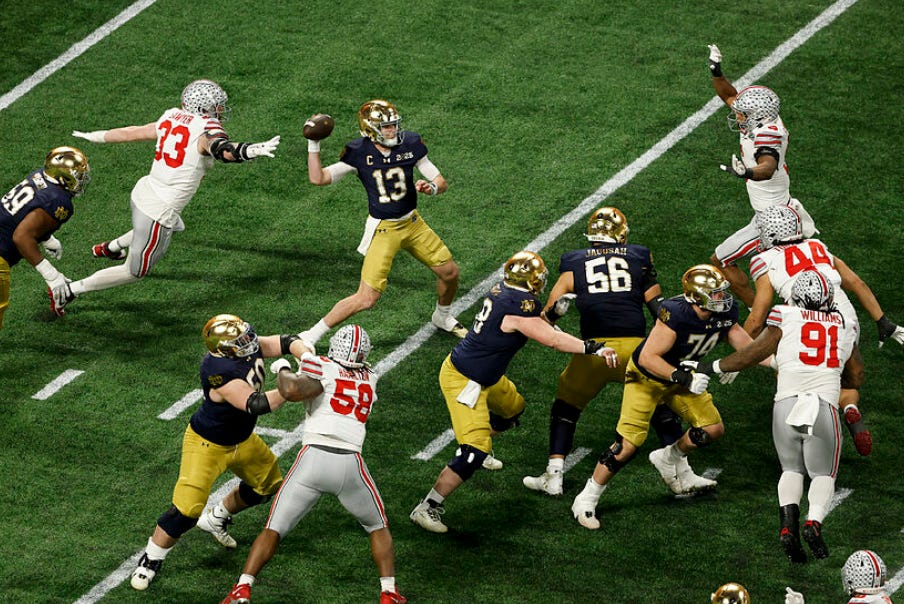
The website nil-ncaa.com has some great numbers—seemingly accurate—projecting revenues and NIL expenses for schools and conferences. I’m not sure what to make of a website constructed by a guy with one of the more rudimentary sites I’ve seen on the internet this year, but I’m going to roll with it. Shoutout to Pat for snowshoeing and cross-country skiing in the image included here alongside his tax advice. He’s a Washington State alum, so you know he’s likely passionate.
Taking a look at the nil-ncaa.com website, curated by Mr. Pat O’Rourke, it reveals the very obvious reality that the highest-achieving (and earning) athletic departments are making much more money than they are allowed to spend on NIL. The $20.5 million revenue-sharing cap is a cumulative average of 22% of Power 5 conference school revenues. However, Ohio State, Michigan, and Texas all generate a 22% revenue figure that’s more than $35 million a year. So, they have to play by the same revenue-sharing rules as the Big 12 conference’s Houston Cougars, who generate a 22% revenue figure that’s less than $5 million—7x to 8x smaller. But the same rules apply.
Completely different schools, completely different athletic departments, completely different wants/needs, but all forced to play by the same rules.
Another reminder: If a school chooses to fund additional scholarships under the House Settlement’s new roster spot + scholarship counts, the cost of additional scholarships will be deducted (to the detriment of the athletes) from the total NIL revenue-sharing cap, up to a maximum of $2.5 million.
Part of the questions that must be considered is, “Will the investment of $2.5 million into scholarships, and the additional spend/revenue-sharing into NIL, benefit the athletic department and university more than if an alternative path was taken?” Based on the overwhelming response of Power 4 schools to fully fund their teams up to the $20.5 million cap, it is fair to assume that most P4 schools believe the aforementioned investment is worthwhile.
So, what’s a school with excess capacity to give to athletes (Michigan, Texas, Ohio State) supposed to do with these abundant revenues, but reduced pathways for supporting the NIL wants and needs of their athletes?
This year, many schools and collectives have done their best to fund as much NIL need as possible, as soon as possible. This involves signing contracts with deliverables only up until June 30th. Dragging those contracts into July or later (i.e., making the contract contingent upon ongoing participation and performance) could run the risk of making that contractual arrangement subject to fair market value consideration and potential disallowance by the Fair Market Value arbitrator, Deloitte.
The assumption for handling future need is that the industry might very well revert to the pre-NIL era ways of funding players with cash/under-the-table dealings. There are stiff penalties planned for schools that aren’t playing by the mutually agreed-upon set of rules for Power 4 schools.
According to The Washington Post, the rewards for making the NCAA basketball tournament are paltry (in comparison to football), spread out over six years, and divided amongst all members of the conference. Meanwhile, individual teams receive massive compensation for making the College Football Playoff. It’s a different asset with different attractiveness to television viewers, advertisers, etc., but the money is very big—and much bigger than basketball. That’s why most schools are dedicating so much money to their football team’s NIL needs. Depending on the school and the conference, a school can make millions of dollars for just making the CFP, which sharply contrasts the hundreds of thousands of dollars a conference makes for their men’s and women’s basketball teams when making the conference tournament.
Just follow the money. The first-round byes for Arizona State and Boise State cost the crown jewel conferences (Big 10 and SEC) too much in potential earnings, so I suspect that after this coming year, the path forward for a first-round bye (and more substantial revenue earning) will become more difficult for Group of Five conference teams AND for teams less likely to be representing the Big 10 and the SEC in the championship. The ACC and the Big 12 are members of the Power 4 Conference group, but the PAC-12 was a member of the Power 5 Conference group until that no longer existed. Life comes at you fast.
Just follow the money when looking for the rationale—or absence of it—when deciphering the future prospects of a team or conference. The deck is getting shuffled, and teams and conferences are waiting to see which cards they’re dealt…



